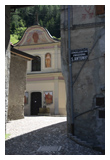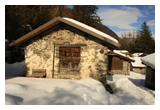| |
Scientific features and evidence of human presence
 The scientific features of the region are various and numerous: they range from the rural settlements, testifying to human presence (made visible by the agriculture and the impressing local architecture) to the zones of pasture land in the higher regions as well as the most original and hardly accessible regions of the steep, wooded slopes. Therefore the area is extremely interesting for scientific investigations. The scientific features of the region are various and numerous: they range from the rural settlements, testifying to human presence (made visible by the agriculture and the impressing local architecture) to the zones of pasture land in the higher regions as well as the most original and hardly accessible regions of the steep, wooded slopes. Therefore the area is extremely interesting for scientific investigations.
Inside the park, in the regions which have at all times been inhabited by human beings, one can find some peculiarities, which make the landscape even more unique. The classic tourist path starts at the village of St. Antonio. Its old centre is well-preserved. Already at the beginning of the path one can see some remaining terrace cultures. They are situated especially on the left side of the valley, below the meeting point of the valleys of Campovecchio and Brandet.
In former times the terraces were cultivated in order to produce food. The farmers preferred local plants - adapted to the climate - like potatoes, rye and barley as well as vegetables, like legumes and also different plants (like the beet) for feeding the animals.
The area is still well-preserved, with petite wooden footbridges and mountain huts of great architectonic interest. The huts remind one of the mountain huts of the “Walser”, a German tribe, which settled from the 10th and 11th centuries onwards in the upper Wallis: the walls of the huts are constructed by spruce beams, in the method of so-called “Blockbau”.
The conservation of that architectural heritage, which requires great skills and abilities in working with wood and stone, is one of the priorities of the nature reserve. Some remodeling, carried out recently, maintains the classic structure. The huts are well-integrated into the area, but today they are used in a different way than in former times.
 If one follows the path in the direction of the higher regions, approaching the twin valleys of Campovecchio and Brandet, one can observe an abundance of footbridges which show architectural and structural peculiarities and which are a characteristic of the area. If one follows the path in the direction of the higher regions, approaching the twin valleys of Campovecchio and Brandet, one can observe an abundance of footbridges which show architectural and structural peculiarities and which are a characteristic of the area.
There are other interesting, human-made constructions as well. They are worth being preserved because they have a certain influence on the habitat: dry stone walls and the so-called “bárech”, relicts of antic dry stone walls, more or less round-shaped, once used as fences for the pasturing animals in the higher regions of the mountains.
The areas that have hardly been influenced by the human presence, show an enormous variety of the already mentioned richness of flora and fauna. Together with the hydrobiologically special conditions of the watercourses the landscape is of a remarkable scientific value.
Historical notes
 The whole area of the valley of Corteno at all times - because of regional, geographical and historical reasons – was united more so with the Veltlin than with the Valle Camonica, nowadays the seat of its administration. The quite simultaneous development of the prehistoric rock engravings in the valley of the Adda and of the Oglio proves that human beings inhabited the region since ancient time. Because of their existence at the same time and because of the geographical proximity one can presume that the Camunni and the Vennoneti were members of the same ethnic tribe, whose origin, maybe Celtic or Ligurian, is not known for sure. The whole area of the valley of Corteno at all times - because of regional, geographical and historical reasons – was united more so with the Veltlin than with the Valle Camonica, nowadays the seat of its administration. The quite simultaneous development of the prehistoric rock engravings in the valley of the Adda and of the Oglio proves that human beings inhabited the region since ancient time. Because of their existence at the same time and because of the geographical proximity one can presume that the Camunni and the Vennoneti were members of the same ethnic tribe, whose origin, maybe Celtic or Ligurian, is not known for sure.
In Roman times, starting at Sondrio and going past Corteno, the Via Valeriana connected the bottom of the Camonica valley with the Aprica-pass and from there led down to the Veltlin. Corteno was important because of its strategic position: it was situated near the most important arterial road which connected the two valleys and was easily accessible by horses.
Because of its marginality and because of the fact that the march through was rather easy for the armed forces who came from the centre of Europe in order to reach the plains of the river Po, the valley of Corteno during the last centuries was occupied by numerous peoples: Alemanni, Lombards, Carolingians, Hungarians (who left their marks on the local nomenclature and on the famous local dish based on lamb, called “cuz”. That dish origins in one of the most wide-spread typical dishes of the nomadic Hungarian animal breeders: the “huz”). Moreover the reign of Brescia, Guelphs and Ghibellines, the republic of Venice, the reign of Milano, lansquenets, the Jacobin Club, Cossacks, the reign of Austria-Hungary as well as the Piedmonts have all left their traces behind. The disadvantages of a border region - like invasions, depredations and robberies - often had been compensated by economic advantages: from 1500 until 1796, as a checkpoint between independent states, Corteno became a big transit centre between the Camonica valley and Switzerland and was the centre of important fairs and markets.
At the beginning of the 19th century Corteo became famous because Camillo Golgi was born there in 1843. In 1906 he was awarded the Nobel prize for medicine. The “museo Golgi”, backed by the communal administration and opened in the June 2006, is quite close to the house where he was born. It preserves important aspects of the life, the work and the scientific discoveries of the Nobel prize winner.
The village of Corteno, like all the villages of the upper Camonica valley, during World War 1 was close to the frontline and the tragic events at the “Adamello” during the “White War” demanded a high rate of victims amongst the local youth. At the end of World War 2 and during the tormenting time of the resistance Corteno was awarded the title of the “most fiercely fighting” village of the province of Brescia.
|
|
